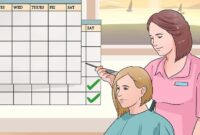How to Dye Bleached Hair – smartesthairstyles.com – Changing your hair color can be subtle or striking, simply covering gray strands or adding highlights, or going blue, purple, pink, or a combination of colors. Bleaching your hair strips it of its natural color, leaving hair ready to take on a new color. It can be a lengthy process that requires focus, so choose a time when you are not overtired and can focus on getting the results you want.
- How to dye bleached hair using store-bought box dye
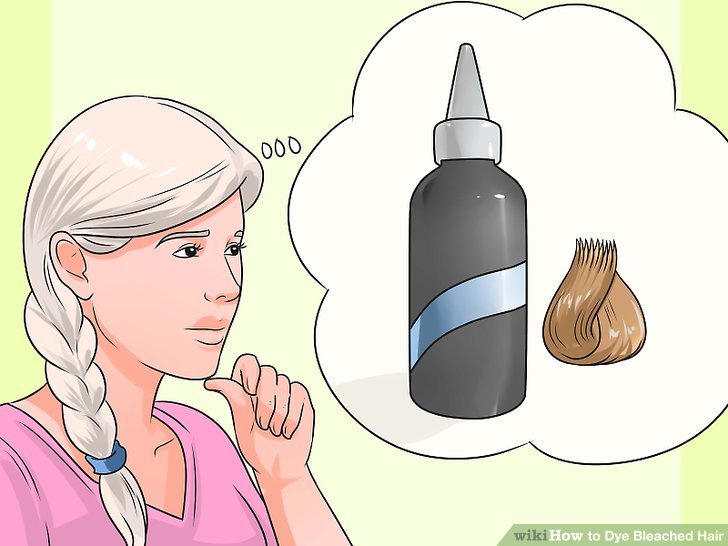
Determine what color you want to dye your hair.After bleaching your hair, you need to decide what color you want it to be. The cuticle layer of your hair strands has been destroyed during the bleaching process, allowing hydrogen peroxide (an important ingredient in hair bleaches) to penetrate the hair strand and remove the color. Depending on your hair’s natural color and how long you left it in the bleach, your hair may now be yellow, white, or reddish. Your hair is now ready to take on color and often takes on color much faster and more intensely than if you had not bleached your hair. You can dye your hair a natural color, e.g. B. in brown, black, red or blonde tones. You can also choose a color like cherry red, blue, purple, pink, etc.
Consider the base color of your hair after bleaching and the base color of the dye you will be using. These could conflict and give you the wrong color. If your bleached hair is yellowish and your dye has a blue base color, you could end up with greenish hair. However, using a purple-based dye will balance out the yellow in your hair, giving you better results. Use a hair color wheel to choose the right shade. To find out the base color of your dye, look on the dye manufacturer’s website for a “palette list” or something similar that categorizes colors into warm, neutral, and cool shades. You can also buy different components of a hair dye kit at a cosmetics store.
Look at your hair in children’s photos. This allows you to determine how your hair reacts to certain colors. If your hair was a warmer color (honey blonde or something), your hair will likely respond with a warmer color now. If your hair was a cooler color (ashy blonde, brunette), your hair will likely have cooler undertones if you dye it now.
Be sure to consider your work environment when choosing a color; Many workplaces consider bright, unnatural hair colors to be unprofessional.
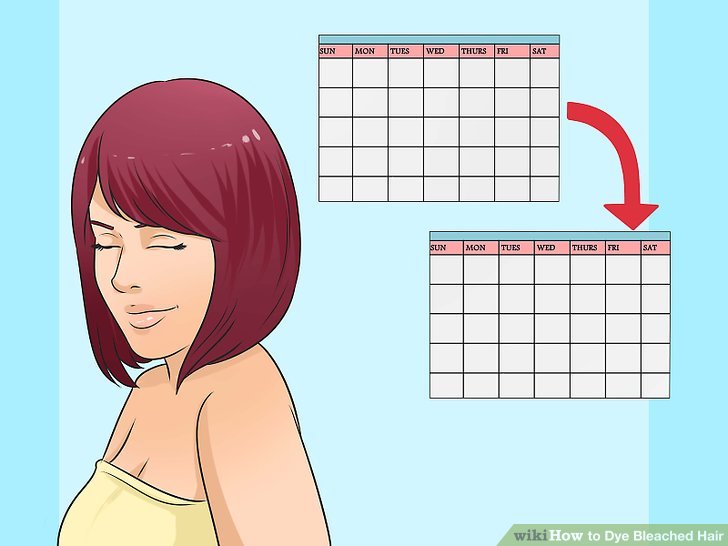
Determine how long you want your paint to last. There are numerous types of store-bought dyes, including permanent, semi-permanent, and color rinses. Each of these will last a different length of time in your hair. These can be purchased at beauty stores, drug stores, grocery stores, and department stores like Target or Walmart.
Permanent dyes are long-lasting and can produce very natural-looking colors. They can also produce very strong or dramatic colors. However, since they are very strong, they can damage your hair because they have to be left on the hair for a long time when dyeing.
Demi-permanent dyes are a step down from permanent and typically last around 20-25 washes. These can dye your hair 1-2 shades darker and also set eye-catching highlights.
Even shorter-lasting temporary hair dyes are also available.
Semi-permanent dyes are temporary, look more natural and typically last around 10 washes. They do not need to be pre-mixed and can be used straight from the packaging. These dyes will progressively fade, particularly when exposed to air and washed. They usually don’t contain ammonia or peroxide, so they’re better suited for brittle or already damaged hair.
Temporary dyes are useful for touch-ups and experimenting with different hair colors. These include conditioners, mousses, sprays, chalks and hair color pencils. They typically coat the hair rather than coloring the core of the hair strand. As a result, these types of dyes wash out within 1-3 washes. You may notice an unwanted color in your hair after the temporary coloring fades. For example, if you bleach your hair and use a temporary blue color, you could end up with green hair after the blue fades.
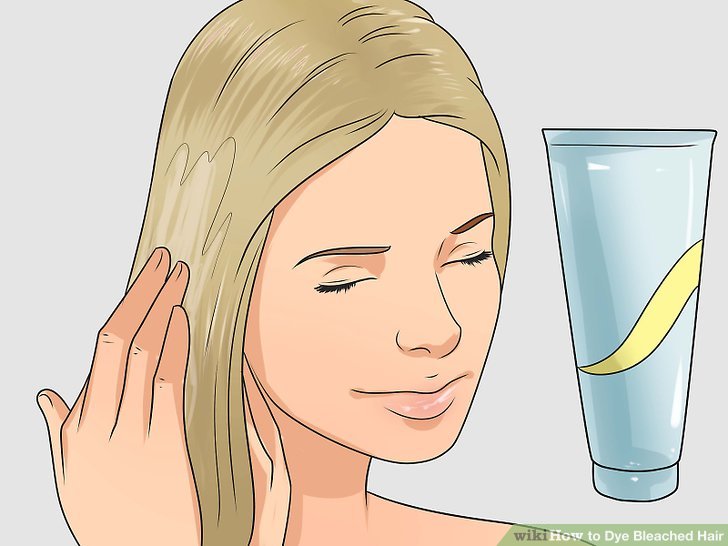
Pre-condition your hair with a deep conditioner.Used a day or two before dying your bleached hair, a deep conditioner will help build moisture in your hair, which may have been damaged by the bleaching process. There is a wide range of deep conditioners available, from cheaper ($5-8) to more expensive ($30 and up) store-bought to more natural DIY conditioners. There are recipes to make your own deep conditioner that usually use food as the base. Search “deep conditioner recipes” online for suggestions using bananas, avocados, mayonnaise, yogurt, eggs, coconut oil, or other foods. This step helps minimize extremely dry and brittle hair after coloring by increasing your hair’s moisture and elasticity, the hair’s ability to return to its natural shape. Ideally you would have preconditioned your hair before bleaching, but if not,
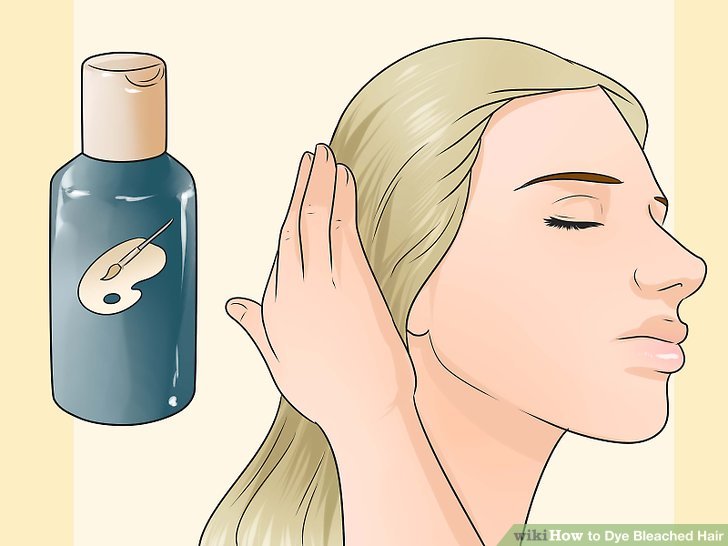
Use a protein filler. The protein filler will help fill in gaps in your hair so the color is applied more evenly, and they also help restore color to your hair. A protein filler may also be added to the hair dye. To put protein fillers directly into your hair, place a small amount in the palm of your hand and distribute throughout your hair. You don’t need to rinse this out before applying the color. Alternatively, you can add the protein filler to your hair dye by adding a very small amount (if you add too much the hair dye will become too runny and therefore really messy).
To match the color of your hair, add protein filler. For example, if you want to dye your hair from bleached blonde to a warm brown, you need to incorporate all three primary colors (red, yellow, blue) into your hair color. For example, her bleached blonde hair provides the yellow color. Use a red protein filler along with an ash brown color with blue undertones. Together they make the right color.
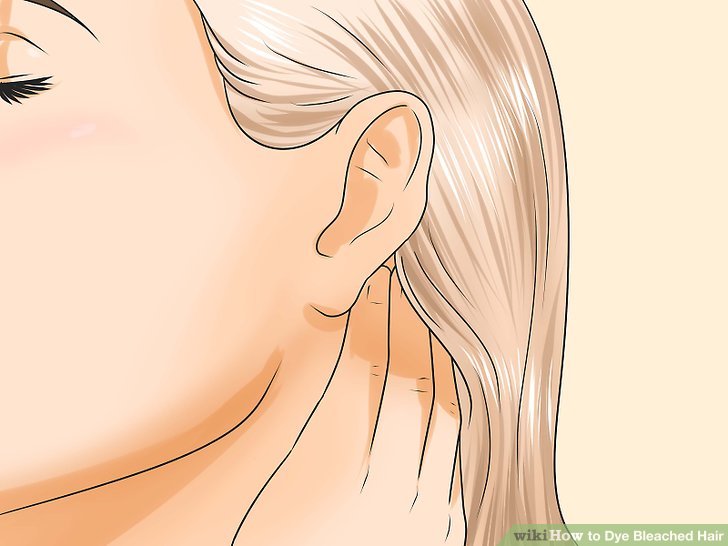
Test for allergic reactions. This step seems like time consuming especially when you want to start coloring your hair. But it’s an important step that will save you from a serious rash (or worse) if you happen to be allergic to any of the dye’s ingredients. To do a patch allergy test, apply a dab of dye to a patch of skin behind your ear. Leave the color on for 24-48 hours and check if there are any allergic reactions such as rash, itching or burning at this point. If you have an allergic reaction, no matter how mild, you should try a different brand. Be sure to test the new brand for allergic reactions as well.
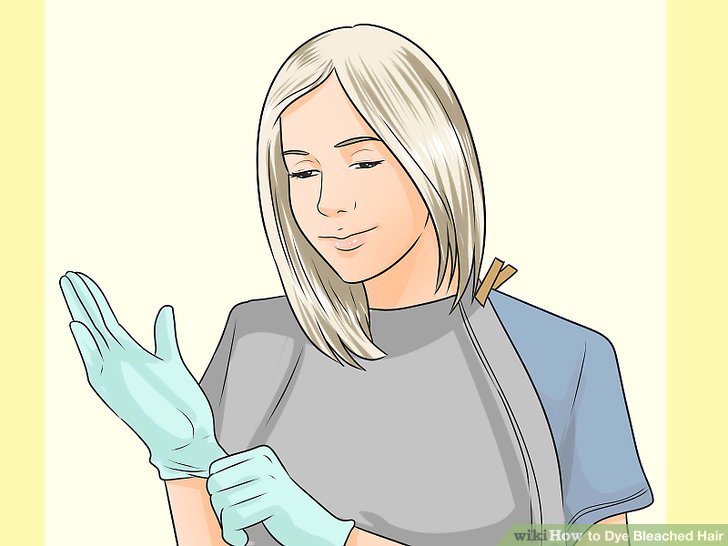
Prevent stains. Chemical-based hair dye can easily stain your skin and hands, so make sure to cover yourself properly. Wear gloves and cover your clothes with an old towel. Apply a small amount of petroleum jelly along your hairline and cleavage to prevent staining. Keep a bottle of alcohol-based toner handy to remove dye from your skin, countertops, and floors.
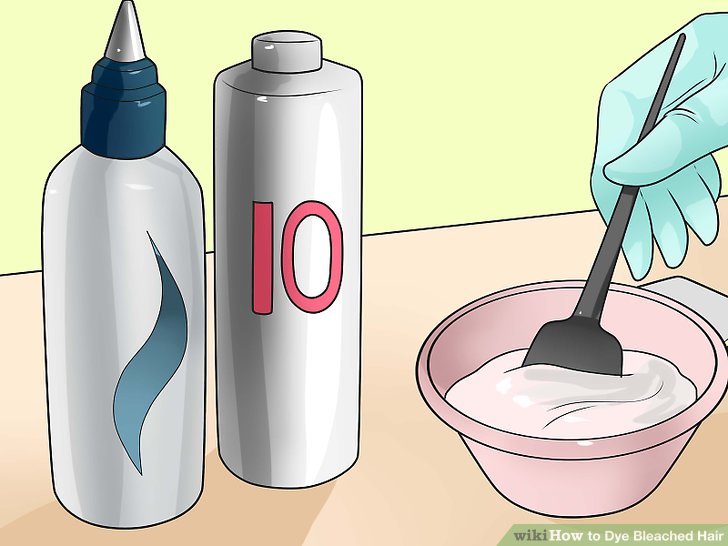
Mix the color. If you purchased permanent dye, you will likely need to mix the color with a developer to get the right color. Follow the directions on the packaging to mix the paint properly.
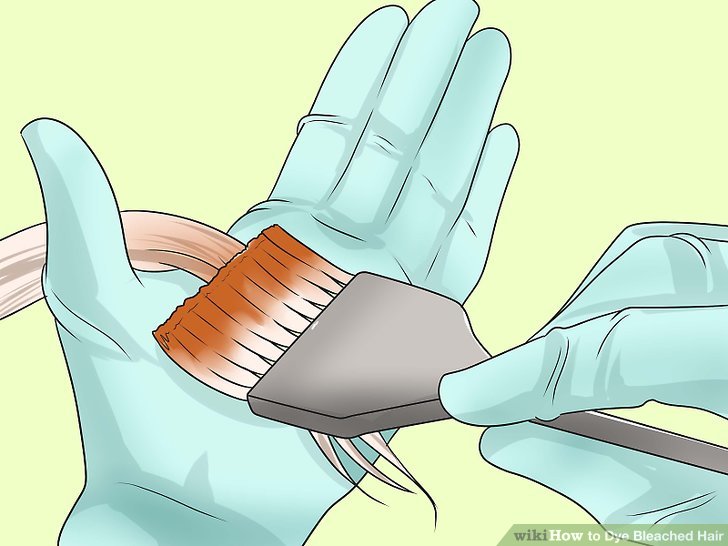
Do a strand test. Gather a small tuft of hair from the back of your neck. Brush the color onto this strand, starting at the roots and working towards the ends. Set your timer to the allotted time recommended in the box instructions (about 20 minutes). Rinse or wipe off the paint and check the color with a white towel. That way you can check if you like the color before you dip your whole head in it. It will also help you estimate how much time you need to leave on the dye.
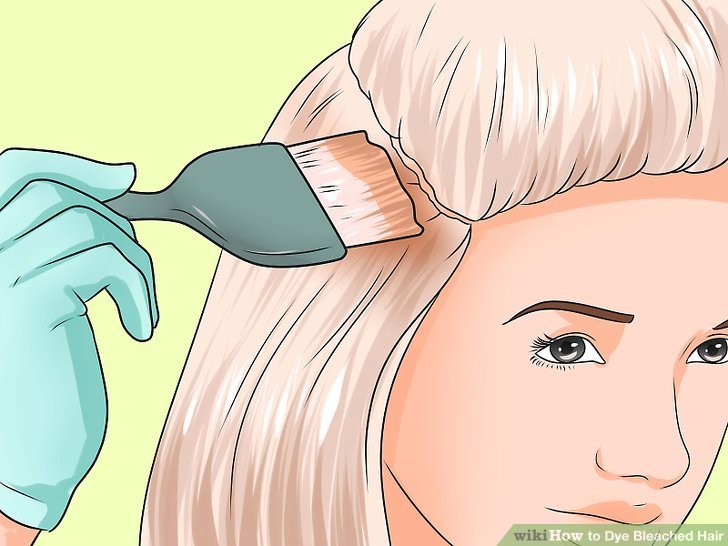
Apply the color to your hair. Divide your hair into four sections. Pin three of these sections back while applying color to the fourth section. Work the color into your hair in about 1 inch sections, starting at the roots and working your hands toward the ends to ensure complete saturation. Once you’ve applied all four sections, rub the color all over your hair as if you were shampooing your hair. Be sure to read the directions on the box to apply the color to your hair.
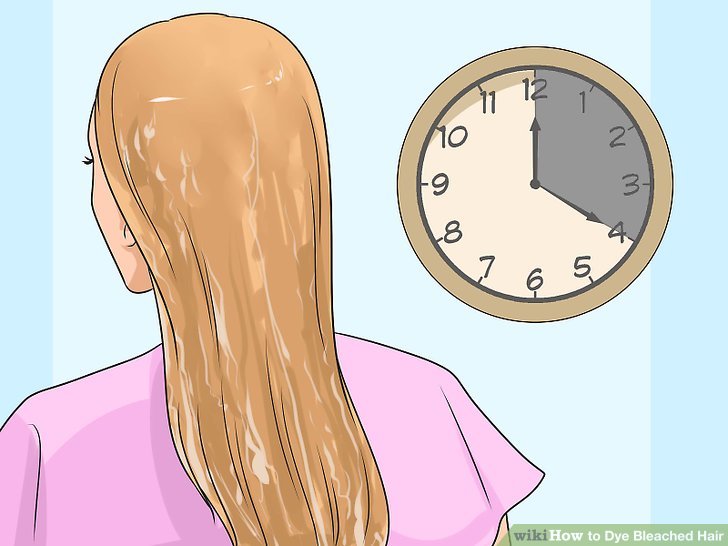
Start your timer. Be sure to read the directions on the packaging for timing recommendations. Typically, you leave the hair color in for about 20 minutes or more, starting after you’ve applied the color to the last strand of hair.
Some dyes even recommend a heated dryer to help the coloring process more effectively.
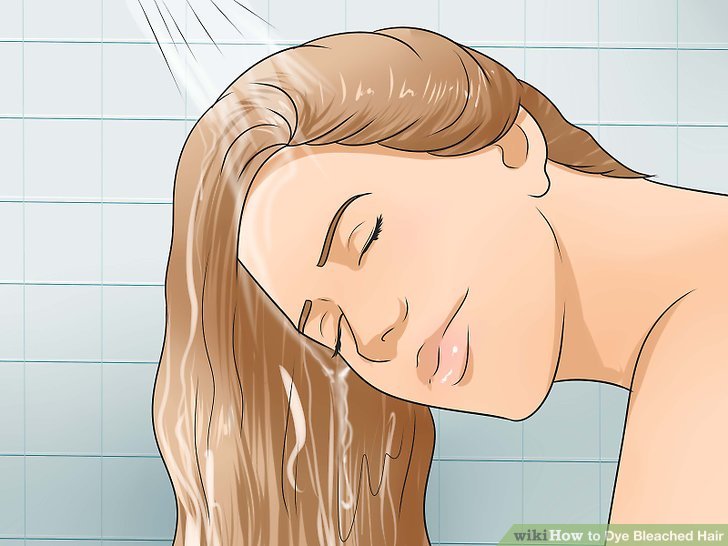
Rinse your hair and apply conditioner. Rinse your hair gently with warm water to rinse out the color residue. Rinse until the water runs clear. Use the packet of conditioner that came with the color and rub it into your hair. Leave on for the time recommended in the package instructions, then rinse out.
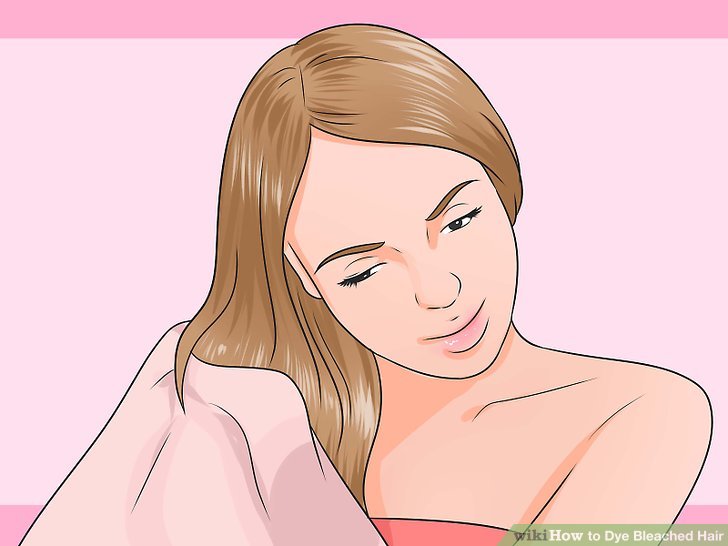
Towel dry your hair or let it dry naturally. Blow drying your hair will only dry it out more and can seriously damage your hair while it is in this fragile state. Be careful not to judge your new color until your hair is dry. The color of wet hair almost always looks darker than the actual color.
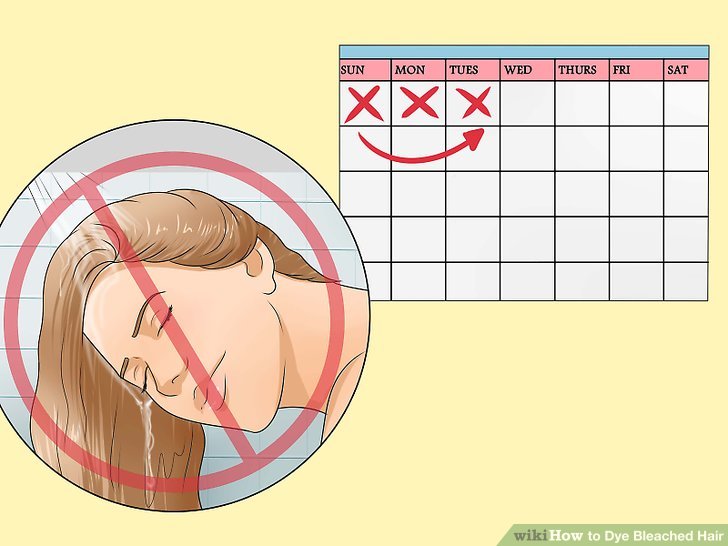
Avoid washing your hair for 2-3 days. Water, soap, and heat can reduce the color’s hold on your hair and cause it to bleed out. Leaving your hair alone for three days can allow the color to penetrate your hair’s cuticles that opened during the coloring process. If the hair dye didn’t last after washing, you can try to dye it again, but you risk damaging it further. If you find that your bleached hair isn’t holding the color, you should probably visit a hair stylist to have it professionally corrected.
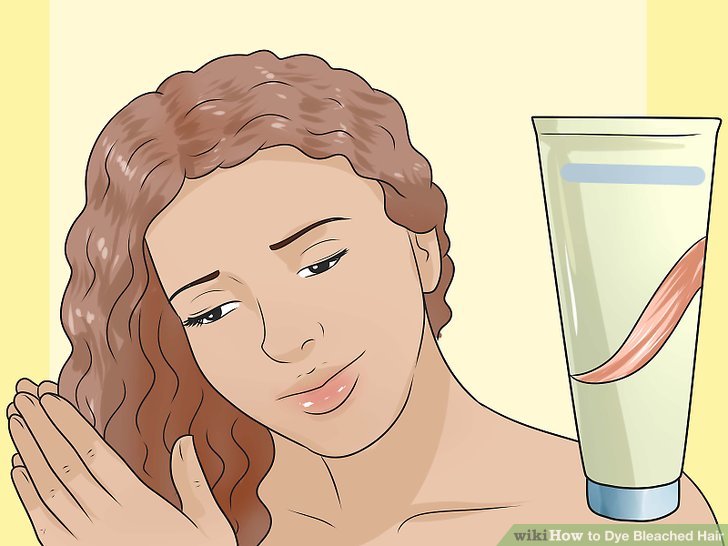
Take care of your hair. Your hair will be brittle and dry after this color treatment and will need a deep conditioning treatment to restore some moisture and elasticity. Use a deep conditioner (store-bought or natural) at least once a week, leave it in your hair for 20 to 30 minutes, and then rinse out. Results can be enhanced by heating your hair with a hair dryer while the deep conditioner is on. If you made your own deep conditioner with food, check to make sure it hasn’t gone bad. If it’s been mixed for more than a few days (or a week if kept in the fridge), throw it away and mix a new batch.
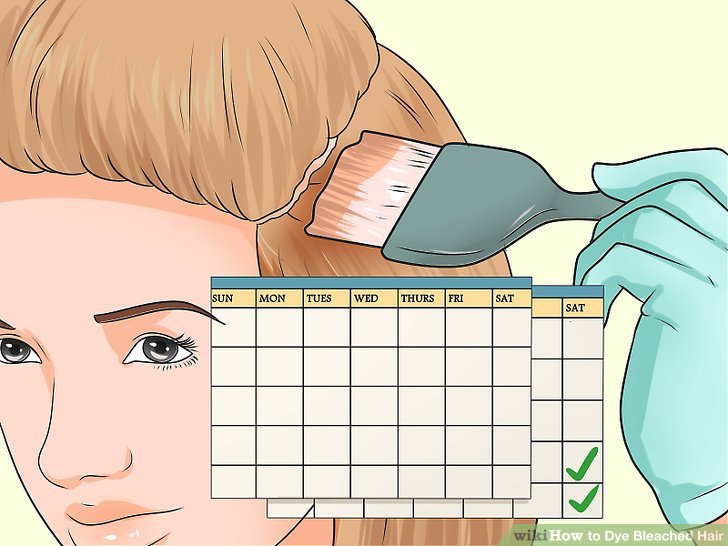
Touch up the color every 6-8 weeks. If you like the color effect you achieved with this dye job, you may want to continue with this color. Even if you choose permanent coloring, it will begin to fade and grow out of your hair within 6-8 weeks. However, you don’t have to completely re-dye your hair. Just focus on coloring your roots, applying the color at the base of your scalp and combing it through the rest of your hair just before you reach the time limit to have the color in your hair.
For the most effective touch-ups, apply dye to the new growth, stopping where it meets the pre-colored hair.
- How to dye bleached hair using of food colors or similar foods as dyes
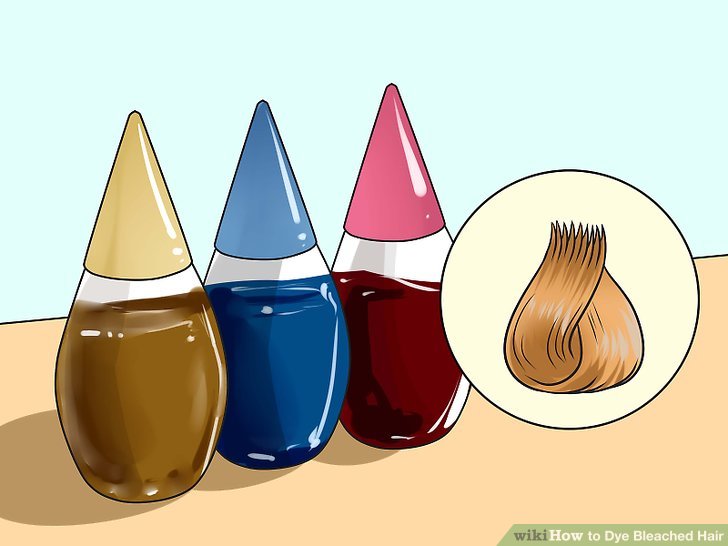
Determine what color you want to dye your hair. After bleaching your hair, you need to decide what color you want it to be. The cuticle layer of your hair strands has been destroyed during the bleaching process, allowing hydrogen peroxide (an important ingredient in hair bleaches) to penetrate the hair strand and remove the color. Depending on your hair’s natural color and how long you left it in the bleach, your hair may now be yellow, white, or reddish. Food coloring typically comes in four colors (red, yellow, green, and blue), each of which can be mixed together to create a wide range of color possibilities. For example, red and green make brown, yellow and red make orange, and blue and red make purple.
Consider the color of your bleached hair. This acts as an additional color in your overall color mix.
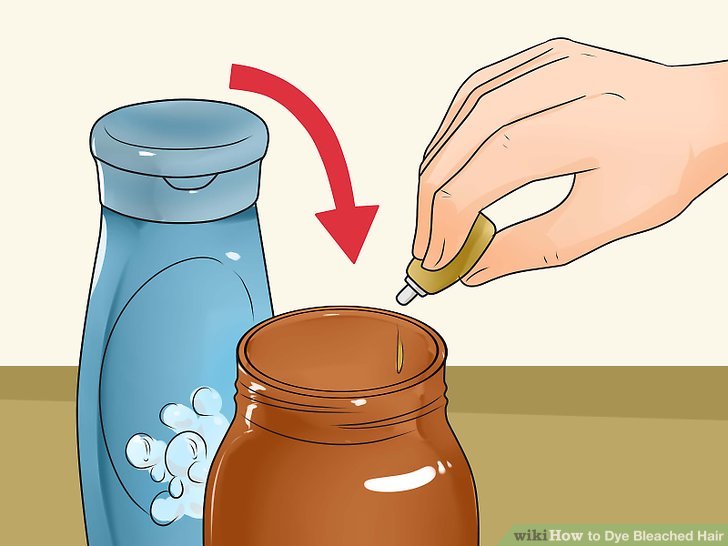
Mix your color. Mix drops of food coloring with shampoo in an empty shampoo bottle. Add 6 drops of dye to every ounce of shampoo. Mix up enough shampoo to cover the amount of hair you want to color. Cap the bottle tightly and shake until the contents are completely mixed. Add 1 tablespoon of water and recap the bottle. Shake for another 2 minutes. Your paint is now ready to use.
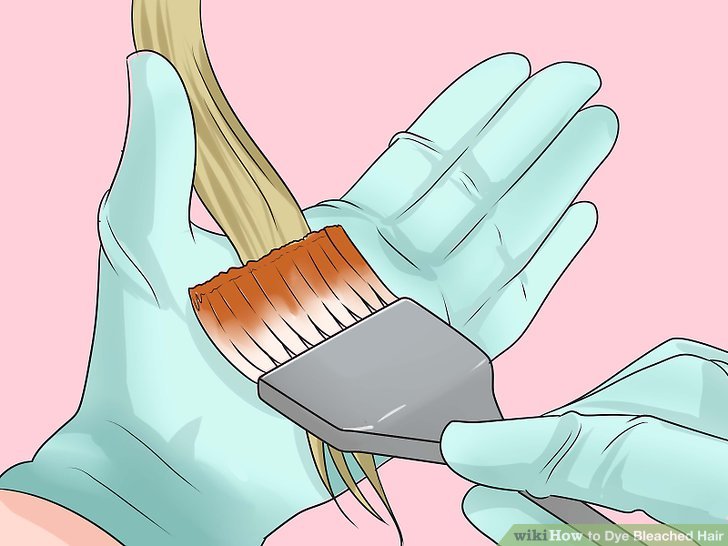
Do a strand test. Gather a small tuft of hair from the back of your neck. Brush the color onto this strand, starting at the roots and working towards the ends. Set your timer for 20 minutes and check the color. Add more time if it seems like the color isn’t quite where you want it. Rinse or wipe off the paint and check the color with a white towel. That way you can check if you like the color before you dip your whole head in it. It will also help you estimate how much time you need to leave on the dye.
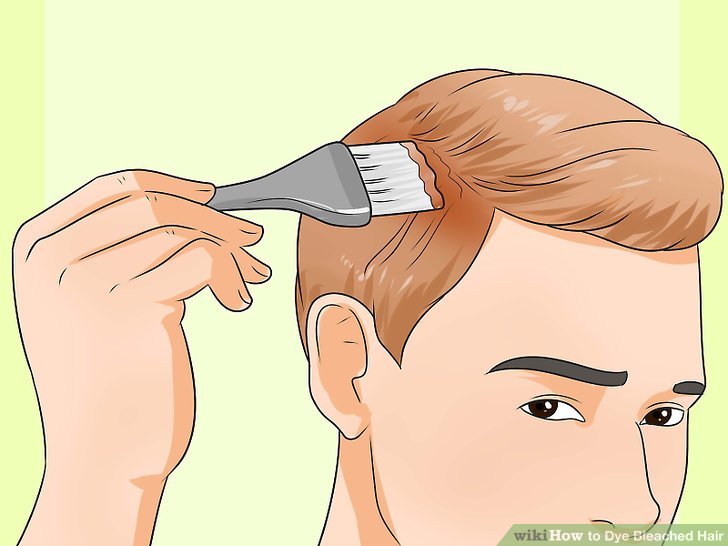
Apply the color to your hair. Divide your hair into four sections. Pin three of these sections back while applying color to the fourth section. Work the color into your hair, starting at the roots and working your hands towards the ends. Once you have applied all four sections, rub the color all over your hair as if you were shampooing your hair.
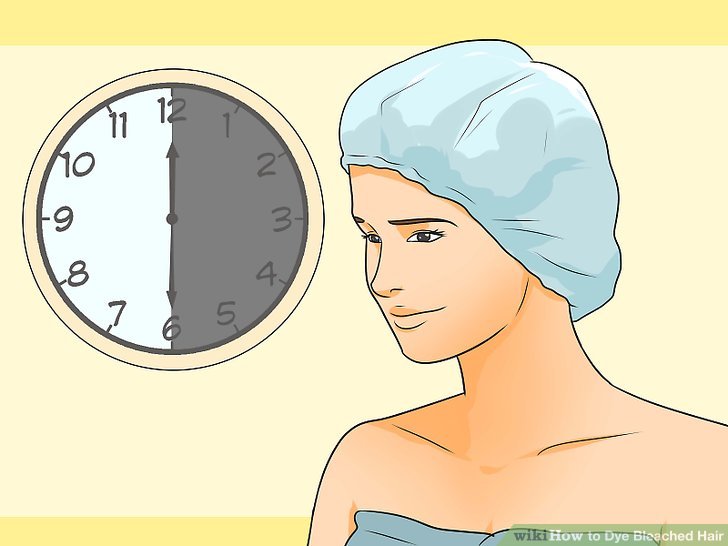
Cover your hair and start your timer. Cover your hair with an old shower cap and leave this color on your hair for anywhere from 30 minutes to 3 hours depending on how dark you want it to be. Start your timer when you’ve applied color to the last section of hair.
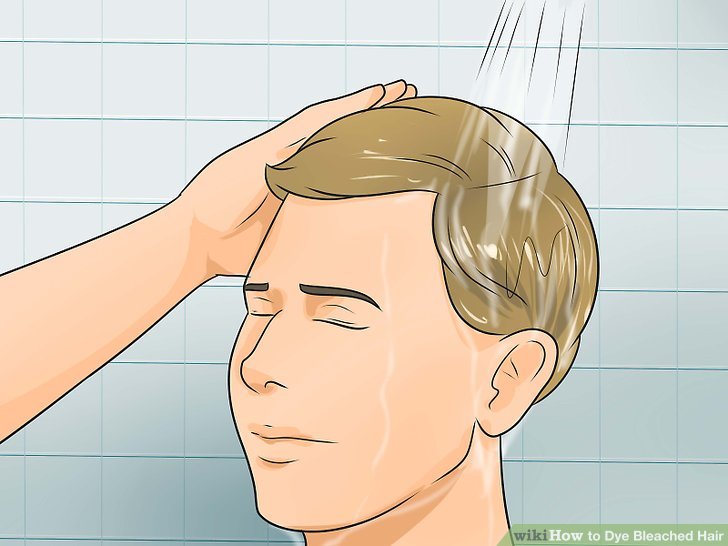
Rinse your hair. Rinse your hair gently with warm water to rinse out the color residue. Rinse until the water runs clear.
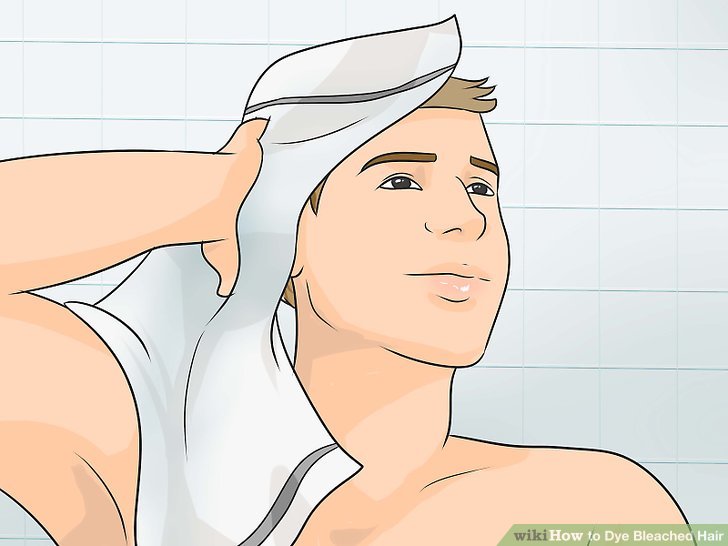
dry your hair Use a towel or a hair dryer to dry your hair. Alternatively, you can let it dry naturally. Because you didn’t use any chemical-based dye to dye your hair, your hair isn’t as dry and brittle, so you can blow-dry right after dyeing.
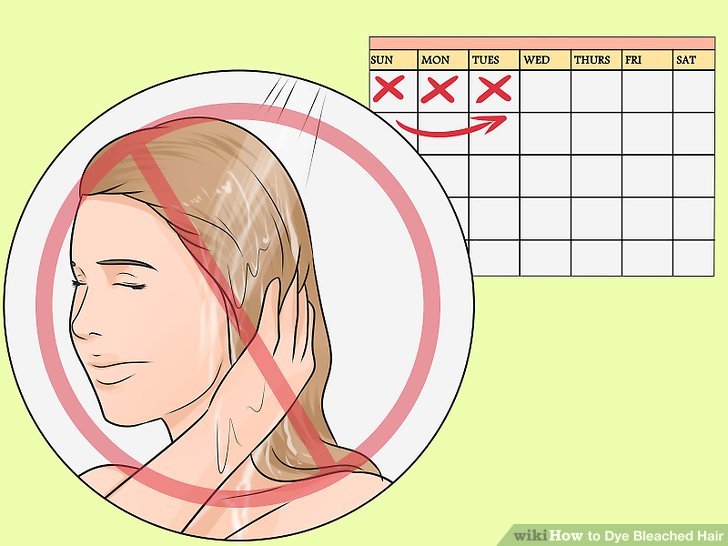
Avoid washing your hair for 2-3 days. Water, soap, and heat can reduce the color’s hold on your hair and cause it to bleed out. Leaving your hair alone for three days can allow the color to penetrate your hair cuticle. You may notice an unwanted color in your hair after the color has faded. For example, if you bleach your hair and then dye it bright red, you could end up with orange hair after the red fades.
- How to dye bleached hair using Kool-Aid as a dye
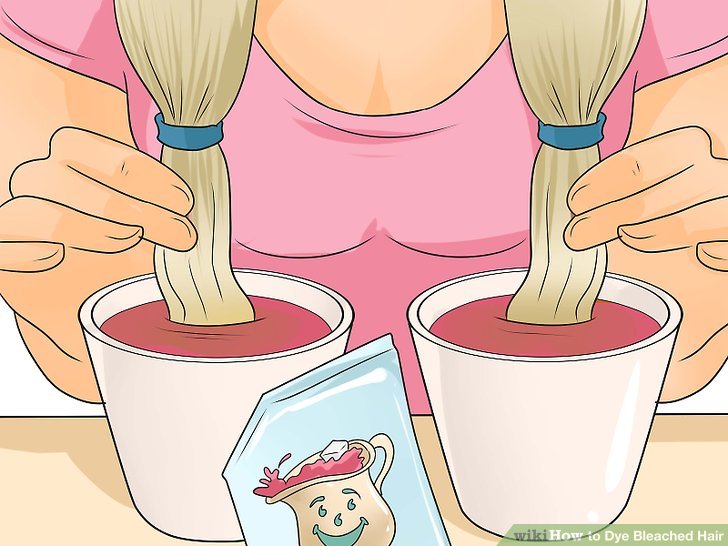
Dip dye your hair with Kool-Aid. Dip-dyeing is a process where you dip the ends of your hair into your color mixture. This is easier than dying your whole head with Kool-Aid, which is harder to control than regular hair dye (because it’s a liquid rather than a cream). It can get messy quickly and easily stain your skin.
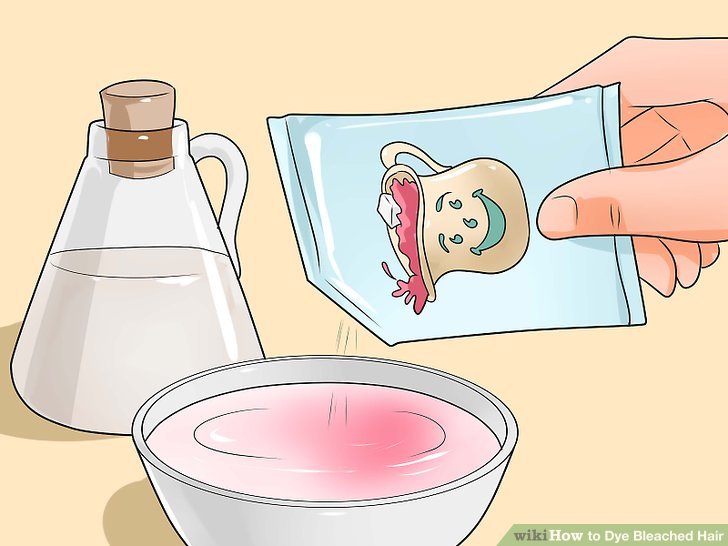
Pick and mix your Kool-Aid color. Choose an unsweetened Kool-Aid flavor that gives you the color you want. Tropical Punch gives a brighter red, Cherry gives a deeper red, and Black Cherry mixed with Strawberry gives a bright red. Consider the color of your bleached hair. This acts as an additional color in your overall color mix. Fill a bowl with 1 cup of warm or hot water. Mix in 3 packets of Kool-Aid crystals along with 2 tablespoons of white vinegar and stir to fully dissolve all of the crystals.
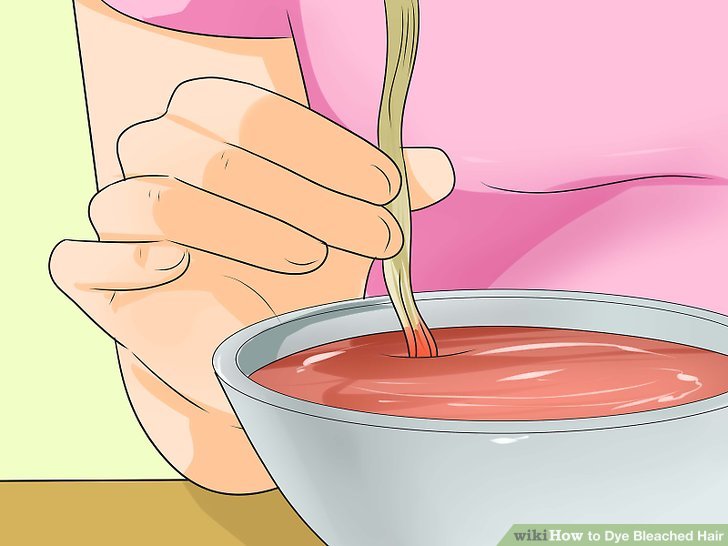
Do a strand test. Gather a small tuft of hair from the back of your neck. Dip a strand of hair in the Kool-Aid dye. Set your timer for 20 minutes and check the color. Add more time if it seems like the color isn’t quite where you want it. Rinse or wipe off the paint and check the color with a white towel. That way you can check if you like the color before you dip your whole head in it. It also helps you gauge how long to leave your hair in the Kool-Aid mixture.
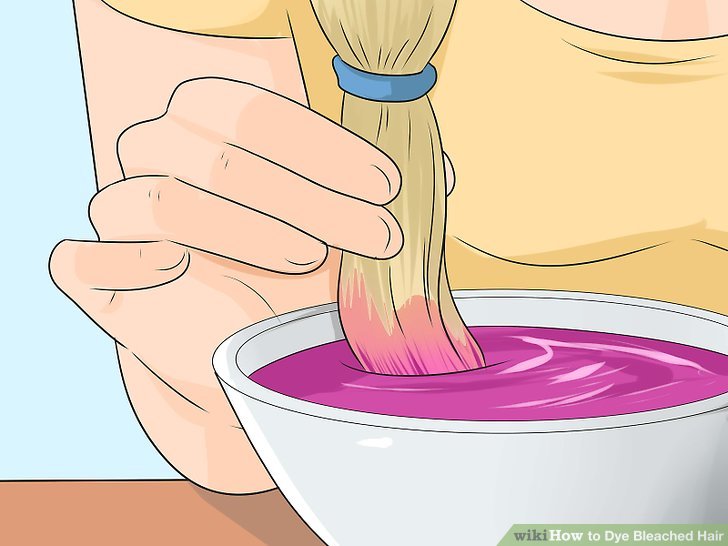
Dive into your hair. Tie your hair in a ponytail and dip the entire ponytail into the Kool-Aid. You will need to sit still for about 30 minutes for the Kool-Aid to soak into your hair. So prepare yourself with a book or movie to keep you busy while you wait. Set your timer to help you keep track of time.
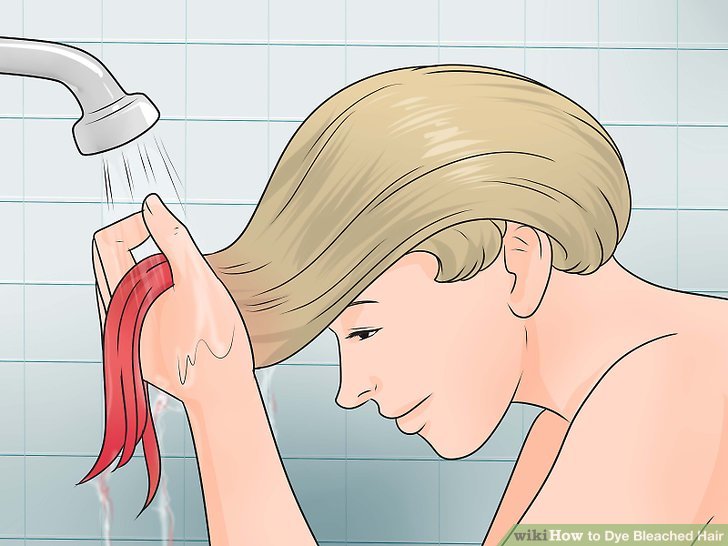
Rinse your hair. Gently rinse your hair with warm water until the water runs clear.
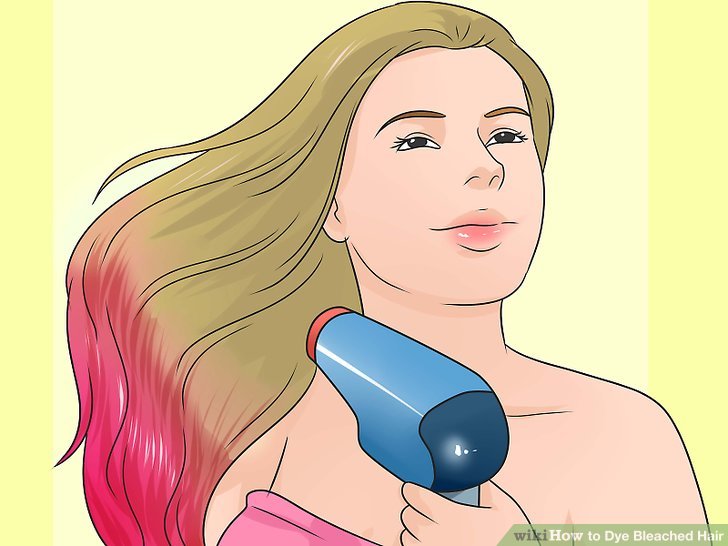
dry your hair Use a towel or a hair dryer to dry your hair. Alternatively, you can let it dry naturally. Because you didn’t use any chemical-based dye to dye your hair, your hair isn’t as dry and brittle, so you can blow-dry right after dyeing.

Avoid washing your hair for 2-3 days. Water, soap, and heat can reduce the color’s hold on your hair and cause it to bleed out. Leaving your hair alone for three days can allow the color to penetrate your hair cuticle. You may notice an unwanted color in your hair after the color has faded. For example, if you bleach your hair and then dye it bright red, you could end up with orange hair after the red fades.
- How to dye bleached hair using of coffee as a dye
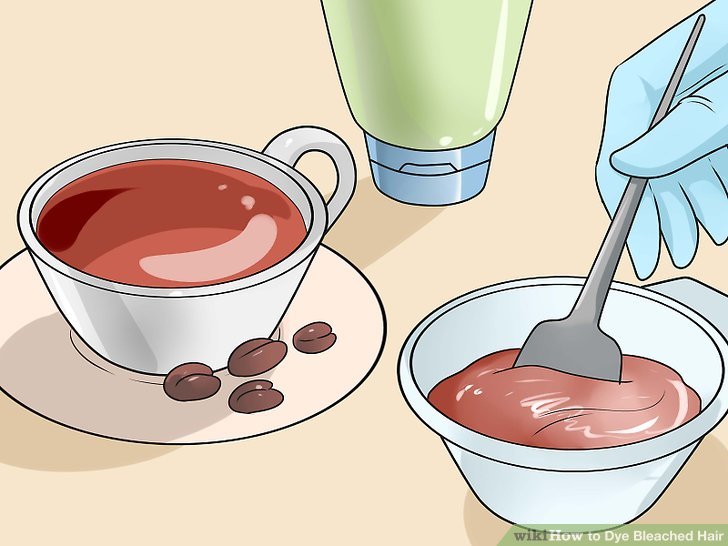
Mix your color. A dye made from coffee will give you a rich, chocolate brown color. Make a pot of really strong, dark coffee and let it cool. Mix 1 cup of brewed coffee with 2 cups of leave-in conditioner in an empty shampoo bottle. Add 2 tablespoons of coffee grounds and stir.
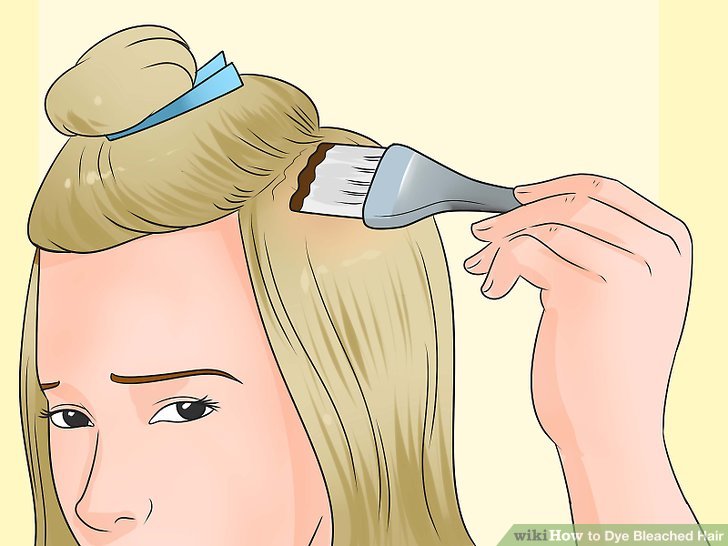
Apply the color to your hair. Divide your hair into four sections. Pin three of these sections back while applying color to the fourth section. Work the color into your hair, starting at the roots and working your hands towards the ends. Once you have applied all four sections, rub the color all over your hair as if you were shampooing your hair.
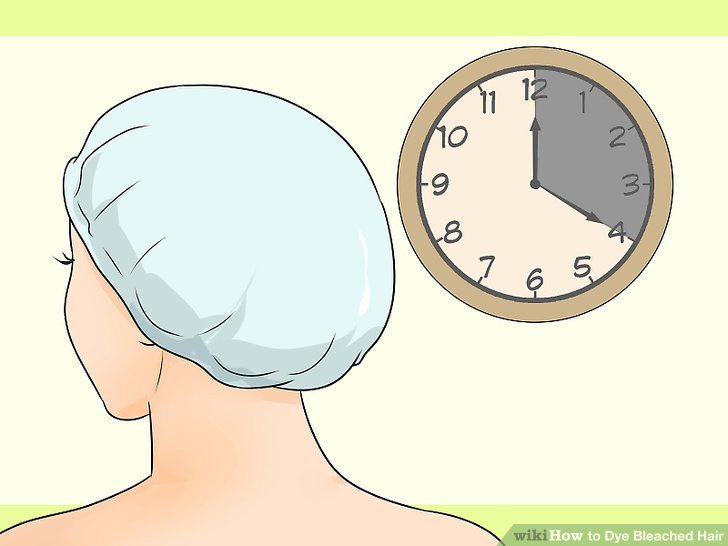
Cover your hair and start your timer. Cover your hair with an old shower cap and leave this color on your hair for about an hour. Start your timer when you’ve applied color to the last section of hair.
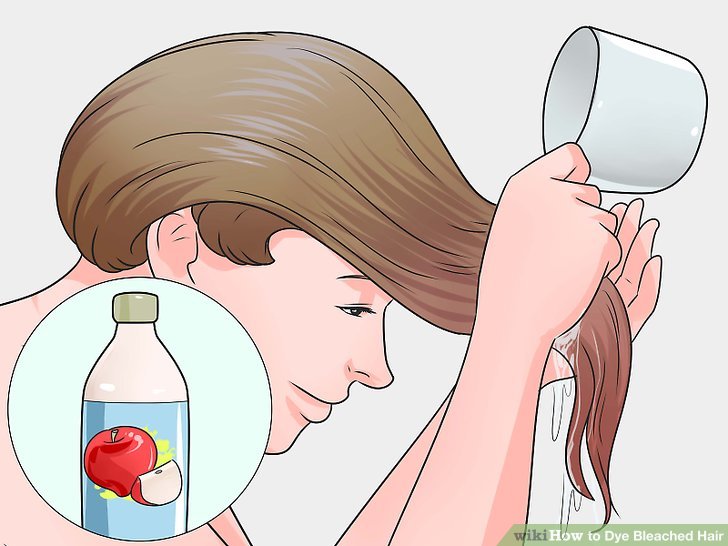
Rinse your hair. Rinse your hair gently with apple cider vinegar, which will help seal in the coffee color on your hair. Then rinse with cold water until the water runs clear.
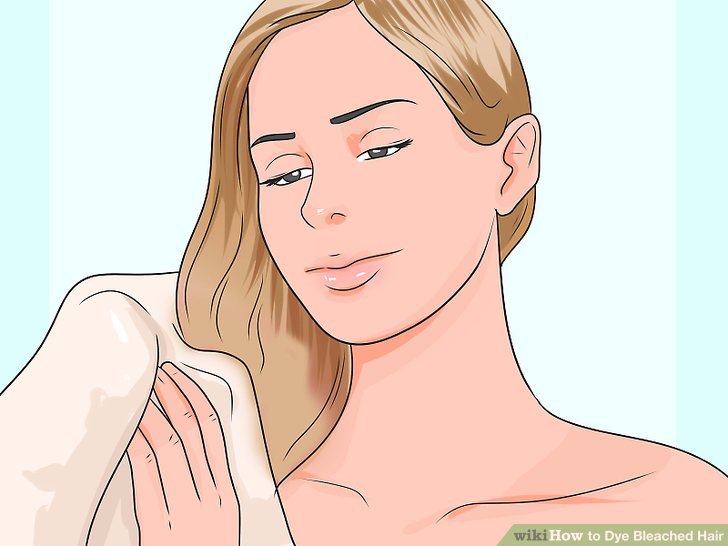
dry your hair Use a towel or a hair dryer to dry your hair. Alternatively, you can let it dry naturally. Because you didn’t use any chemical-based dye to dye your hair, your hair isn’t as dry and brittle, so you can blow-dry right after dyeing.
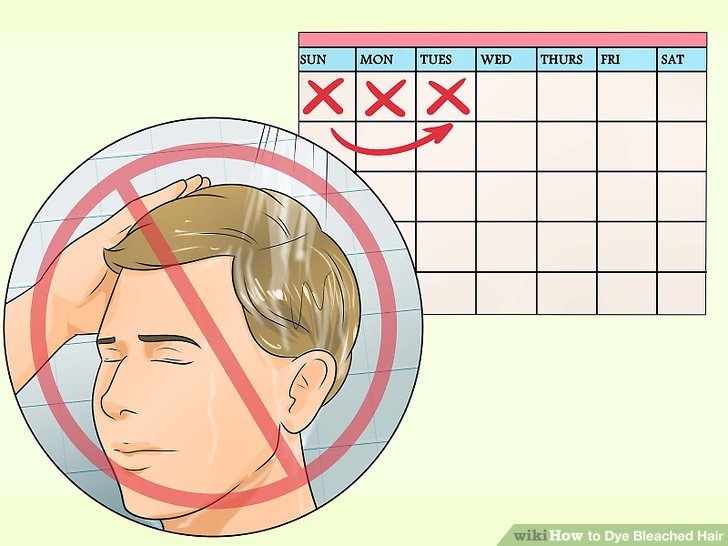
Avoid washing your hair for 2-3 days. Water, soap, and heat can reduce the color’s hold on your hair and cause it to bleed out. Leaving your hair alone for three days can allow the color to penetrate your hair cuticle.
- How to dye bleached hair using of coffee as a dye of herbal or plant-based dyes
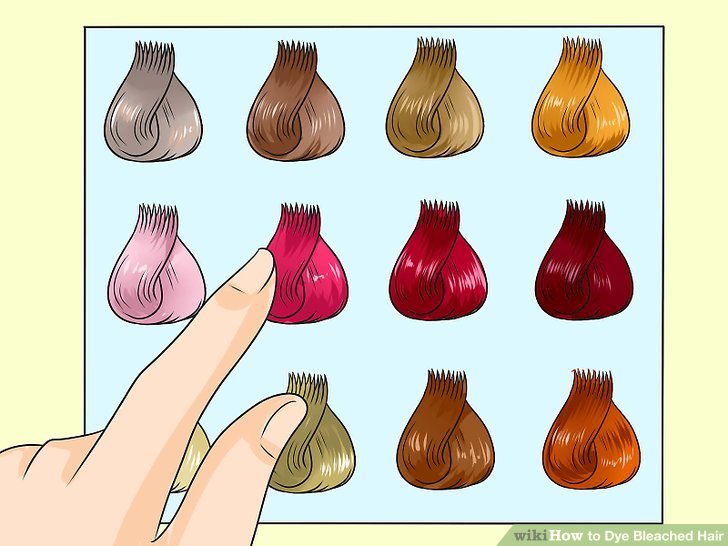
Determine what color you want to dye your hair.After bleaching your hair, you need to decide what color you want it to be. The cuticle layer of your hair strands has been destroyed during the bleaching process, allowing hydrogen peroxide (an important ingredient in hair bleaches) to penetrate the hair strand and remove the color. Depending on your hair’s natural color and how long you left it in the bleach, your hair may now be yellow, white, or reddish. Herbal and plant based dyes can give you natural looking colors without the risk of using harsh chemicals. Teas, henna and other herbs are useful and effective for coloring hair. Tea can give you a range of colors, from brown or black to blonde or red. Use black tea to get dark colors, chamomile, to intensify blonde colors and red or rooibos tea to get red colors. Henna produces dark, rich colors and is available at health food stores or herbal supply stores. It can help make your hair feel thicker as it individually coats each strand of hair. Consider the color of your bleached hair. This acts as an additional color in your overall color mix.
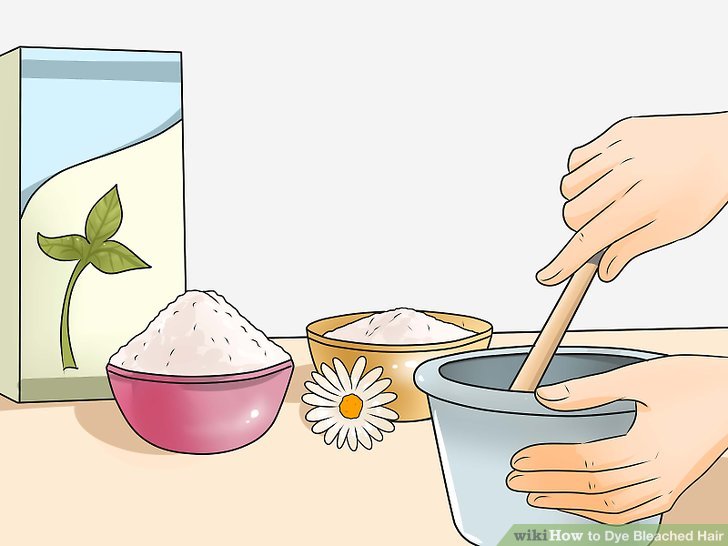
Mix your color. Use the recipes listed here or search online for more recipes to get the right proportions for mixing colors that will dye your hair the color you want.
Use henna powder. Mix henna powder with chamomile or another lighter herb to reduce the color it imparts to your hair. Mix two parts henna powder with one part chamomile powder in a non-metallic bowl. Add boiling water to get a thick paste. Then stir in a tablespoon of vinegar and allow the mixture to cool.
Use tea bags or loose tea. Add 3-5 tea bags (or loose leaf equivalent) to 2 cups of water. Cook for 3-5 minutes and let cool. Pour tea liquid into an empty applicator bottle.
Use black walnut powder. To achieve very dark brown hair, mix ¼ cup black walnut powder in 3 cups water overnight. Use this daily as a conditioner to get a dark rich color.
Look online for other blends. Search “Natural Hair Color Recipes” to find recipes using other herbs such as marigold petals, calendula flowers, rosemary leaves, etc.
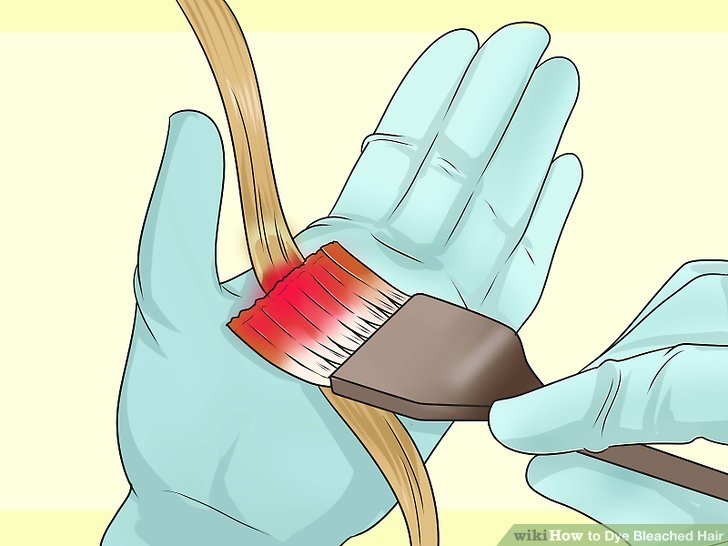
Do a strand test. Gather a small tuft of hair from the back of your neck. Brush the color onto this strand, starting at the roots and working towards the ends. Set your timer for 20 minutes and check the color. Add more time if it seems like the color isn’t quite where you want it. Rinse or wipe off the paint and check the color with a white towel. That way you can check if you like the color before you dip your whole head in it. It will also help you estimate how much time you need to leave on the dye.
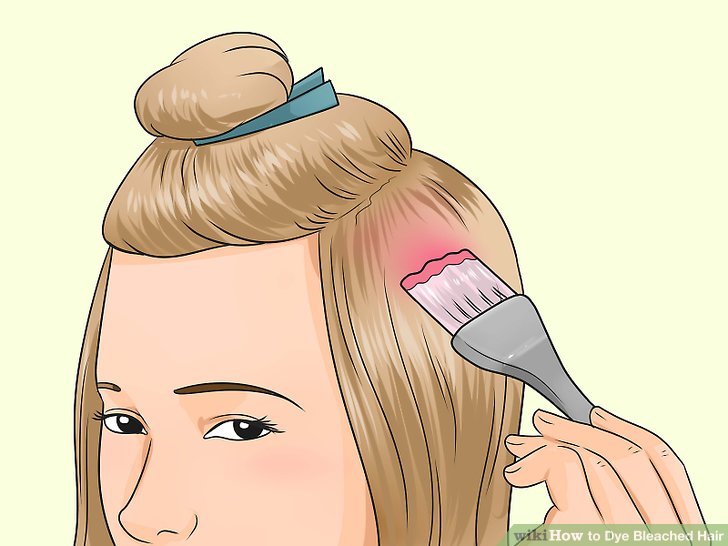
Apply the color to your hair. Divide your hair into four sections. Pin three of these sections back while applying color to the fourth section. Work the color into your hair, starting at the roots and working your hands towards the ends. Once you have applied all four sections, rub the color all over your hair as if you were shampooing your hair.
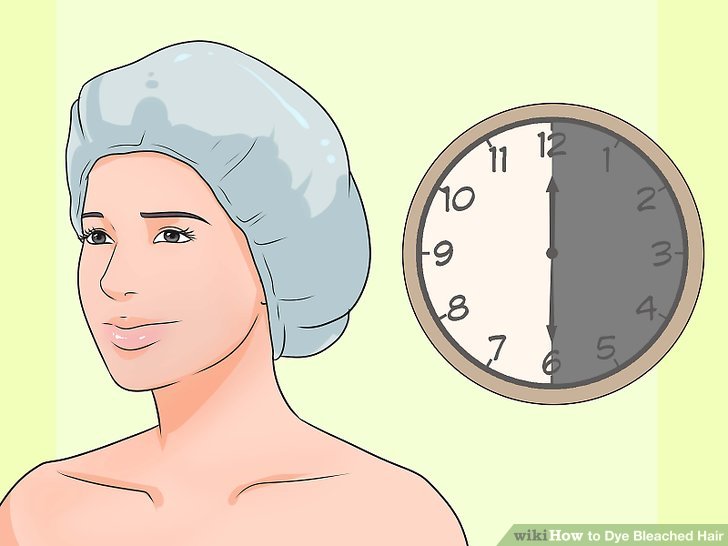
Cover your hair and start your timer. Cover your hair with an old shower cap and leave this color on your hair for anywhere from 30 minutes to 3 hours, depending on the herb or plant and how dark you want your hair to be. Start your timer when you’ve applied color to the last section of hair.
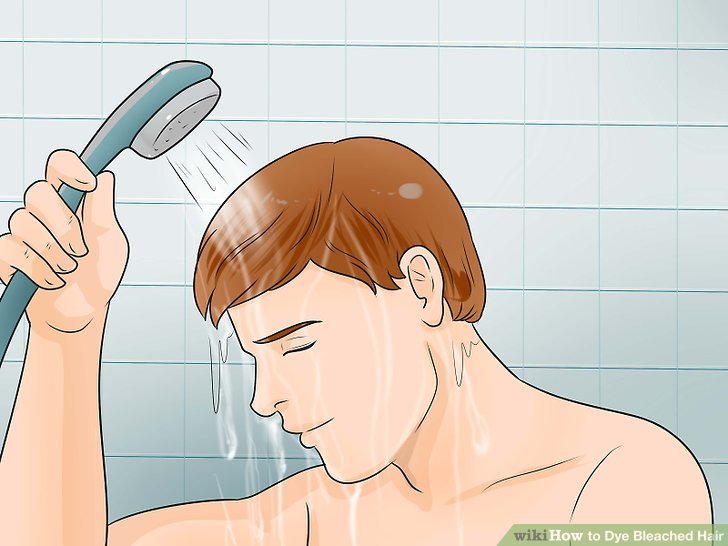
Rinse your hair. Rinse your hair gently with warm water to rinse out the color residue. Rinse until the water runs clear.
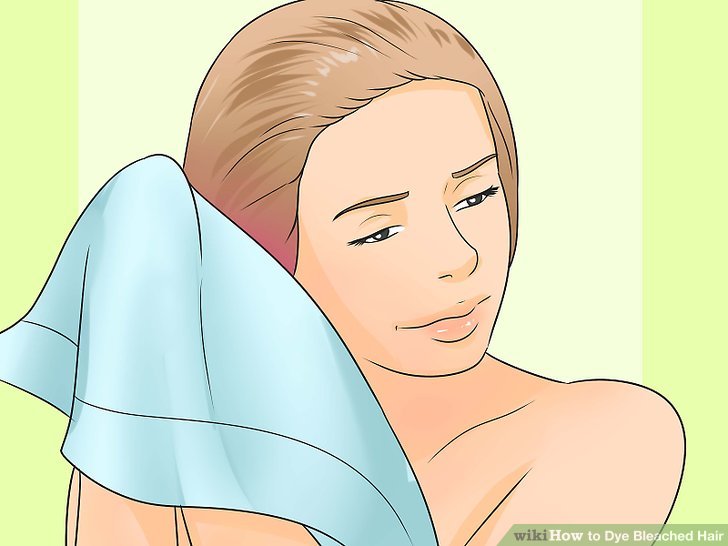
dry your hair Use a towel or a hair dryer to dry your hair. Alternatively, you can let it dry naturally. Because you didn’t use any chemical-based dye to dye your hair, your hair isn’t as dry and brittle, so you can blow-dry right after dyeing.
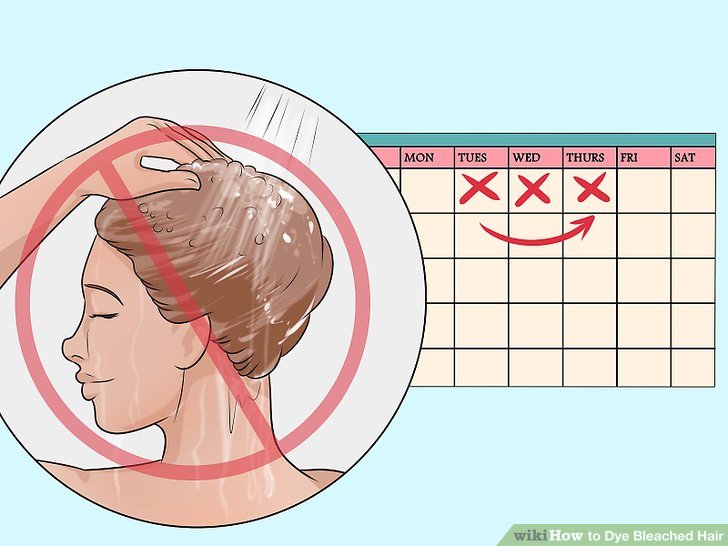
Avoid washing your hair for 2-3 days. Water, soap, and heat can reduce the color’s hold on your hair and cause it to bleed out. Leaving your hair alone for three days can allow the color to penetrate your hair cuticle.
- Visit to the hairdresser
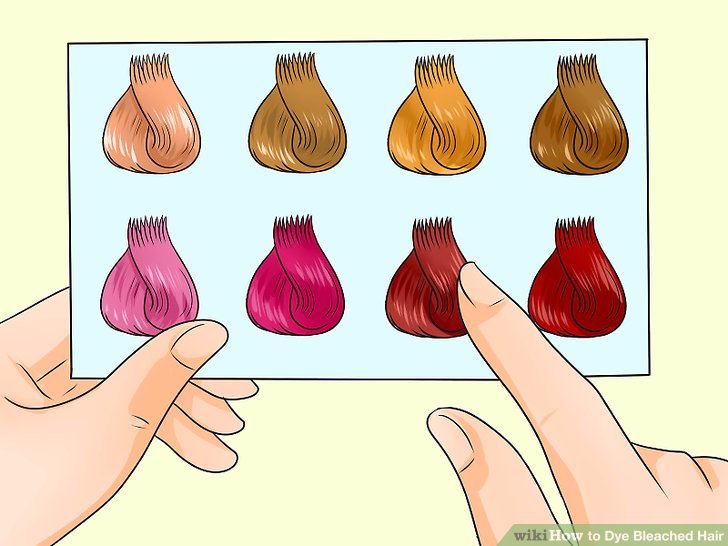
Determine what color you want to dye your hair.After bleaching your hair, you need to decide what color you want it to be. The cuticle layer of your hair strands has been destroyed during the bleaching process, allowing hydrogen peroxide (an important ingredient in hair bleaches) to penetrate the hair strand and remove the color. Depending on your hair’s natural color and how long you left it in the bleach, your hair may now be yellow, white, or reddish. You can choose a natural color like shades of brown, black, red or blonde. You can also choose a color like cherry red, blue, purple, pink, etc. Be sure to consider your work environment when choosing a color; Many workplaces consider bright, unnatural hair colors to be unprofessional.
Look at your hair in children’s photos. This allows you to determine how your hair reacts to certain colors. If your hair was a warmer color (honey blonde or something), your hair will likely respond with a warmer color now. If your hair was a cooler color (ashy blonde, brunette), your hair will likely have cooler undertones if you dye it now.
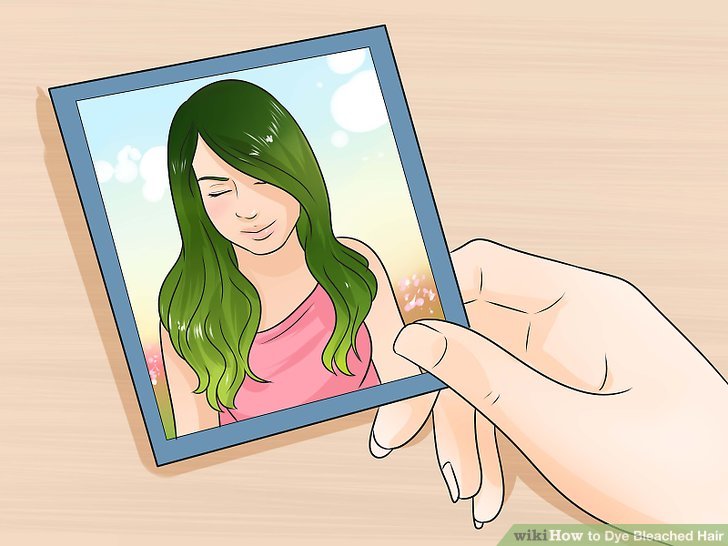
Bring a picture. Find a picture of the color you want in a magazine and bring it with you. This will help convey your vision to your barber.
Magazines, Pinterest, and social media are great places to look for photo inspiration.
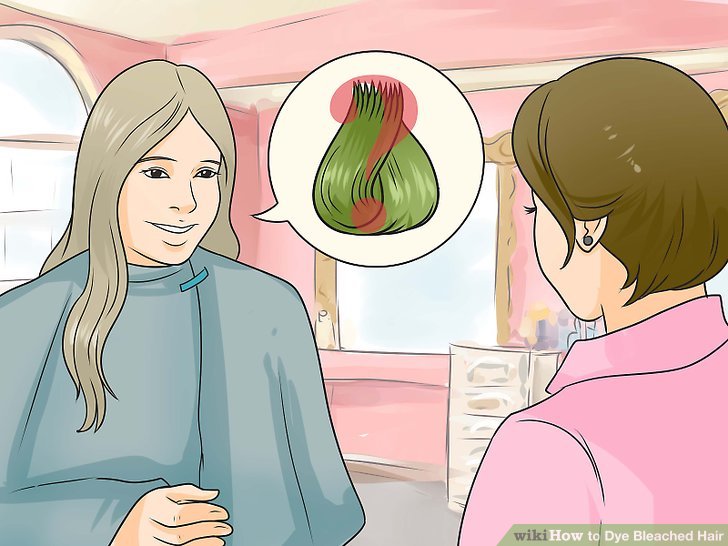
Ask your hairdresser for his opinion. They are experts at blending colors, incorporating highlights and lowlights, and achieving the best color. They are schooled in the chemistry of these hair dyes and understand how they work together.
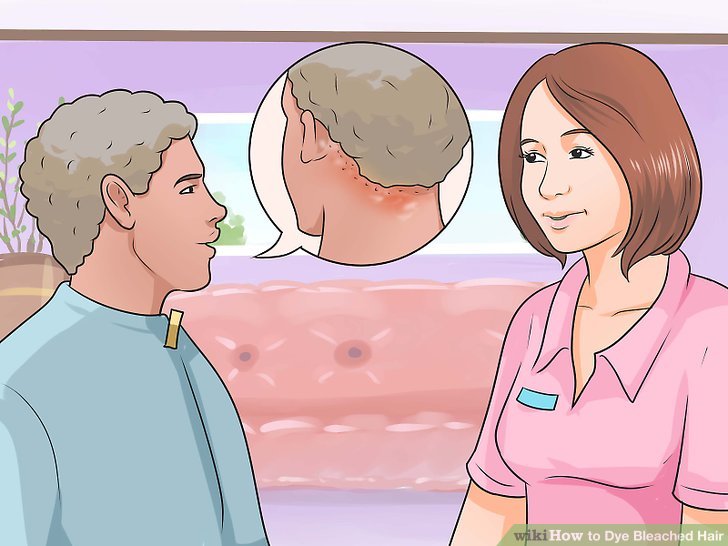
Let your stylist know if you are sensitive to hair color or other chemicals. Your barber may want to do an allergy test and ask you to reschedule your appointment for another day. Alternatively, they may have suggestions for milder hair dyes that would work for you.
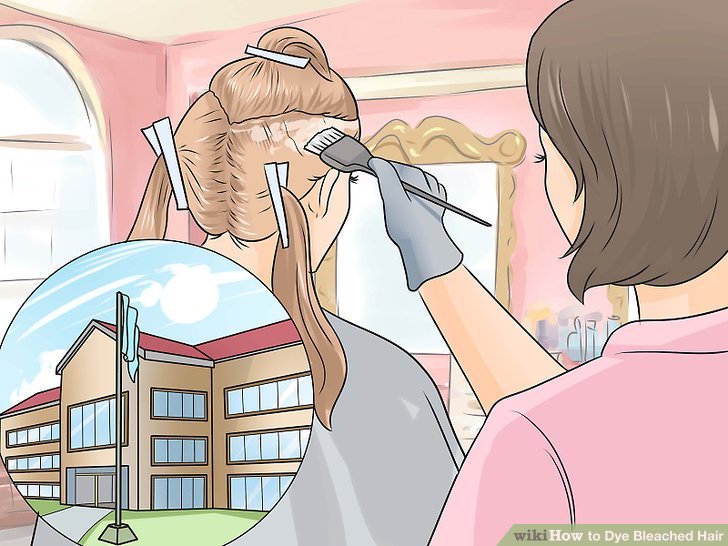
Consider getting your hair colored at a beauty school. Dying your hair at a hair salon can be expensive, usually starting at $100 and increasing from there. Beauty schools are training centers for hairdressers and offer cheap rates for haircuts and hair treatments. Apprentices are mentored by qualified professionals who offer advice and fix errors before they cause harm. The level of the stylist will likely determine the price.
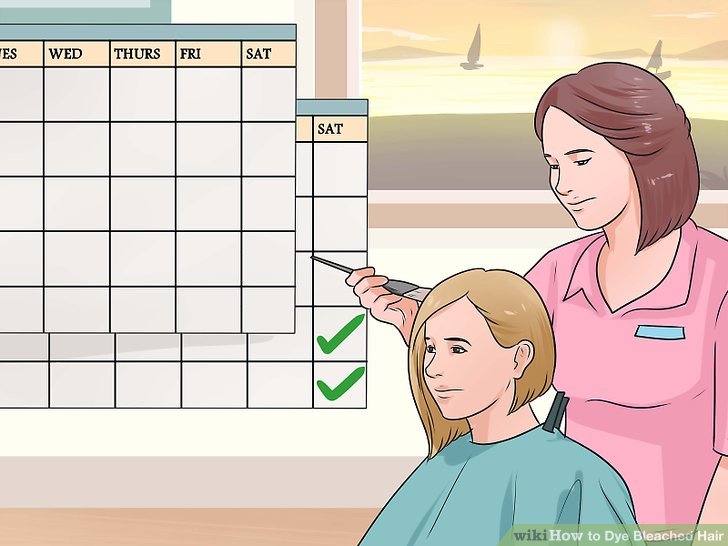
Make your next appointment. To keep your hair color vibrant, visit your stylist every 6-8 weeks for a touch-up.



